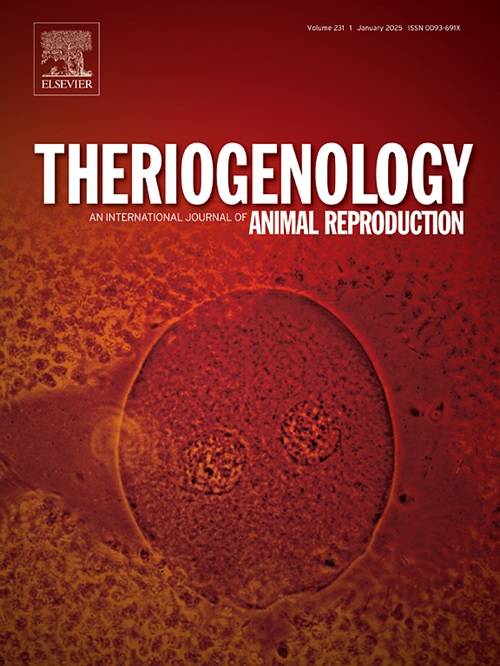Analyzing estrous cycle dynamics with different protocols of 4.7 mg deslorelin implant aplication in bitches
IF 2.4
2区 农林科学
Q3 REPRODUCTIVE BIOLOGY
引用次数: 0
Abstract
The use of deslorelin acetate implants for estrus induction is increasingly popular, but optimal timing for administration and removal remains uncertain. This study aimed to compare the effectiveness of estrus induction during early (90–120 days after heat cessation, G1: n = 7) and late anestrus (≥160 days after heat cessation, G2: n = 7; G3: n = 7) and at different implant removal times (Progesterone (P4) ≥ 3 ng/ml (G1 = 3.5 ± 0.3 ng/ml; G2 = 3.4 ± 0.4 ng/ml) vs day of Progesterone ≥5 ng/ml (G3 = 5.0 ± 1.0 ng/ml)). Studied bitches were divided in two groups and implanted with desloreline in early (G1: n = 7) and late anestrus (G2: n = 7) and removed at LH peak (G1, G2) or after it (G3: n = 7). A control group was created, which included bitches with a spontaneous estrous cycle (С: n = 8). Assessments included vaginal cytology, hormone measurements by enzyme-linked fluorescence assay (ELFA) method and ultrasound examination (US). In the group implanted during early anestrus (G1), heat signs appeared between days 5 and 7 after implant insertion, but no pregnancies were observed. Whereas implantation during late anestrus resulted in earlier onset of heat signs. In G2 and G3, cytological proestrus began two days earlier (on day 3 after implant insertion), and the estrus phase progressed more consistently compared to G1. Moreover, in G2, the cycle closely resembled a spontaneous sexual cycle and did not affect the subsequent fertility of the implanted females. Only in this group (G2) pregnancies were noted. The prolonged implant retention led to hormonal imbalance and no conception (G3). We conclude that estrus induction was less effective in early anestrus compared to late anestrus. For a successful and fertile estrous cycle, the implant should be administered during late anestrus (more than 160 days after the end of heat) and removed around the LH peak (P4 ≥ 3 ng/ml, measured with the mini VIDAS™ device).
求助全文
约1分钟内获得全文
求助全文
来源期刊

Theriogenology
农林科学-生殖生物学
CiteScore
5.50
自引率
14.30%
发文量
387
审稿时长
72 days
期刊介绍:
Theriogenology provides an international forum for researchers, clinicians, and industry professionals in animal reproductive biology. This acclaimed journal publishes articles on a wide range of topics in reproductive and developmental biology, of domestic mammal, avian, and aquatic species as well as wild species which are the object of veterinary care in research or conservation programs.
 求助内容:
求助内容: 应助结果提醒方式:
应助结果提醒方式:


